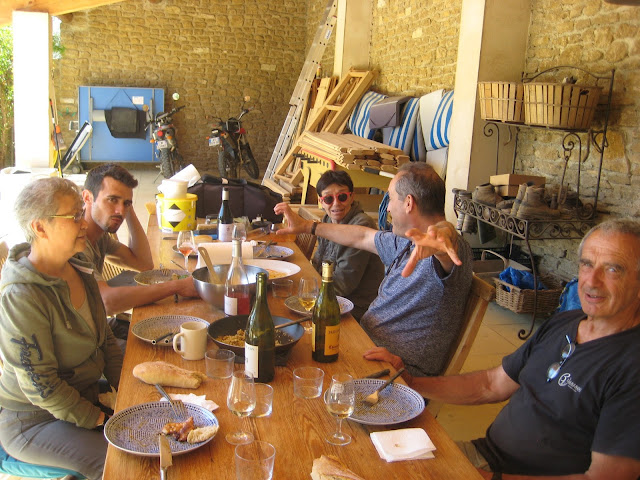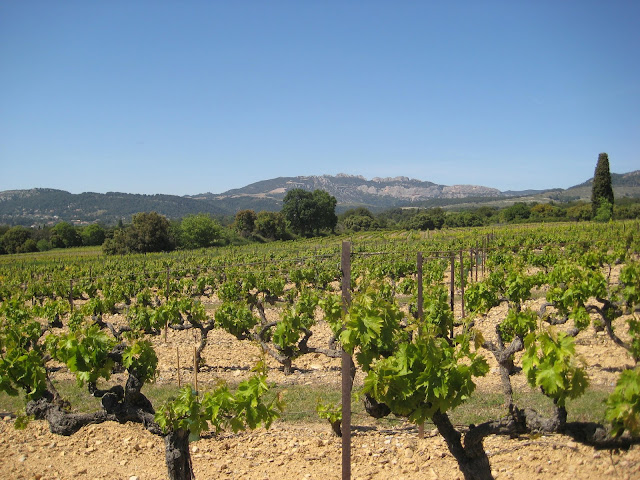April 21-22
Remember this is the land of wine and honey. So Friday Joanna got one jar of lavender honey and another of flower honey.
Friday is Carpentras market day. We got there before eight, so early that a number of vendors were still setting up.
Larry was buying food for Saturday. That gave us time to explore the town.
Narrow medieval streets.
An arcade decorated with parasols.
And local color.
We had time to find two historical sites in the town.
The cathedral may date to the 12th or 13th century. The structure is Gothic, but the interior shows the effects of later times.
The sanctuary behind the high altar, for instance, has a descending dove in a window surrounded by golden rays of metal in a starburst: much like Bernini’s work in the chapel at St. Peter’s, only a little smaller.
The sanctuary behind the high altar, for instance, has a descending dove in a window surrounded by golden rays of metal in a starburst: much like Bernini’s work in the chapel at St. Peter’s, only a little smaller.
Larry told us that the cathedral has a special side entrance that was for the Jews, who were permitted to come in and pray.
Carpentras also has one of the oldest synagogues in France.
We followed a couple of signs directing us to it, and then the supply of signs ran out. Actually, we were standing in a large square with the synagogue at our right, but didn’t know it at first.
Then we saw a small plaque on the wall with a line of Hebrew characters across the top.
The door was locked but another sign asked us to ring the bell. A voice came out of the wall and told Larry we’d have to come back at two. That timing didn’t work for us, so we didn’t get in.
We came back to the house and took a long nap.
I got up around four and went with Larry to Vacqueyras. First stop was the co-op cave. Vacqueyras has a wine co-op, which has merged with the Beaumes-de-Venise co-op, and Claude is president of both of them now.
Claude met us there and went into the office. He came out and introduced us to Marine—not Le Pen, the nationalist presidential candidate, but the girl whom Pierre, Claude’s son, is dating.
All the wine is good here. We bought a Vacqueyras Grand Cuvee.
Next stop was a cave operated by a winemaker called Montmirail. Larry bought a white and I bought a red.
We also went to a shop that sells wine from most of the producers in the area. We left without buying anything, but when we were about a block away, Larry started muttering to himself.
He had liked one of the wines we sampled, Domaine Sang de Cailloux (I think). Finally he said, “I’m going to go back and buy it.” Which he did.
Dinner was a leg of lamb in a wine reduction with roast baby potatoes on the side.
We had bought wine in Chateauneuf-du-Pape specifically to go with this meal. One cost 30 or 40 euros and the other was a little more than a hundred. We bought them mainly to thank the Chabrans for having us in their home for a week.
Both wines are extraordinarily good. Larry engineered a blind taste test, which Joanna administered.
Neither Larry nor I could tell which was which. We both guessed wrong. It’s probably going to be the only time in my life when my wine palate is going to be in the same league as Larry’s.
Dessert was a basket of local strawberries that Larry had bought at the Carpentras market. They’re in season now, and everywhere we go we see signs for “fraises de Carpentras.”
The area is justly famous for its strawberries, which are small and sweet and full of flavor.
Saturday we took it easy in the morning, hanging around the house. We got up late. I got some writing done.
The mistral had quit and the weather was warm. We ate lunch outside. We had a cut of pork called a spider, because of its unusual shape, and a hot sausage called merguez.
We had that with La Garrigue rose and two different whites from Chateauneuf-du-Pape. One was the Eddie Feraud we had bought earlier in the week and the other was made by the Beaumes-de-Venise co-op using Chateauneuf-du-Pape grapes.
Pierre works the family vineyards. There is one right behind the house, and the other day, he was using a very narrow tractor to weed between the rows of vines.
Joanna said she wanted to try working in the vineyard, too. Apparently, there is nothing more wasteful of time for a wine grower than greenhorns in the vineyard, but Pierre agreed and set aside Saturday afternoon. Joanna asked me to come along to take pictures.
We rode in Pierre’s truck to a field not far from the house, up a narrow road and then into an unpaved track, around a bend, up a slope, and so forth. Enough turns to get me lost, but it was only a matter of minutes from the house.
Wine-growing in this region is like that. Families have holdings here and there.
The Chabran vineyards will be next to others owned by different growers.
We were issued gloves, and I got mine on at the second try. At first I was putting them on backwards, with the rubberized side on the backs of my hands. I forget why that seemed like a good idea at the time.
Pierre very patiently showed us what to prune from each vine. You are supposed to take everything except two, at most three, new shoots emerging from a pruning from last year called, I believe, a “leader.” Shoots coming out of the main branches or from below the leader have to go. This leaves more of the vine’s energy for the development of grapes.
Joanna took to it right away. I was a little slower. No, a lot slower.
The vines grow about knee high on me and I had to bend down to reach them. This is not a good working position for me, so after about a half hour, I was having trouble walking on the rough ground. My sense of balance, never that great to begin with, was seriously disrupted.
Supporting wires run along the rows of vines, and every now and then there is a post to hold them. Also to hold Harry. Very useful.
Pierre called time and said he had other things to do.
We were in the field for maybe an hour. and pruned two and a half rows out of, I dunno, three or four dozen rows, or maybe several thousand.
I also don’t know how much help I was. Probably very little.
I was able to walk to the truck, so there was no ambulance or stretcher involved. Back at the house, I had a few glasses of water and started to nap in a folding chair.
I thought better of that and went to bed for a couple of hours.
Larry had bought a fowl called a pintade at the Carpentras market. It’s a bird with a lot of dark meat. The British call it a Guinea fowl. The Americans don’t often eat it.
That was cooked in rose wine with three heads of garlic, some rosemary, and some thyme.
The garlic cooked in the skin, and when it came out, it was buttery soft and had lost most of its pungency. I like garlic as a discreet background flavor in many things. Usually if I can smell the garlic in a dish, I don’t want to eat it.
I tried a couple of cloves. The garlic squeezed out of the skin and tasted mild indeed. Two were enough, though.
The pintade is slightly gamier than chicken, which made it very tasty. The juice was excellent over pasta and cauliflower.
We had that with a Vacqueyras red that Larry had bought. It was almost as good as a Chateauneuf-du-Pape. We also shared another red (I forget which one) that I had picked up in our travels.
That was a younger wine, so Larry transferred it from the bottle into a decanter to aerate it.
Sophie and Claude had been invited out to dinner. Sophie had made pies using lemons from the family’s vacation house in Corsica. It was Larry, Joanna, and I at the Chabrans’ house that night, and Sophie left us half a lemon pie.
The flavor was intense and wonderful.
Larry drove us to Avignon Sunday morning. We approached town along the Rhone, past the broken bridge and the Palace of the Popes to the Tren a Grande Vitesse station, which is outside town.
Right now, we are speeding across the hilly French countryside, past vineyards, and meadows with sheep, horses, cows, and goats, and hillsides covered with trees. I haven’t noticed any bison farms, so I know we’re not in Wyoming.
Be well, all, and don’t count your pintades before they’re hatched.
Harry















No comments:
Post a Comment